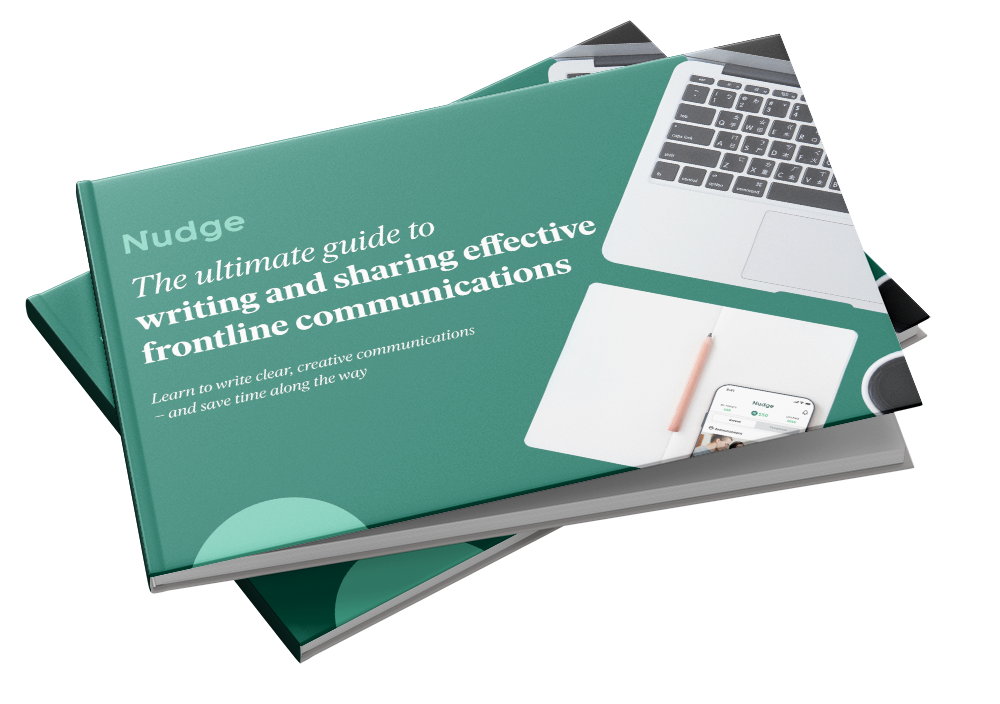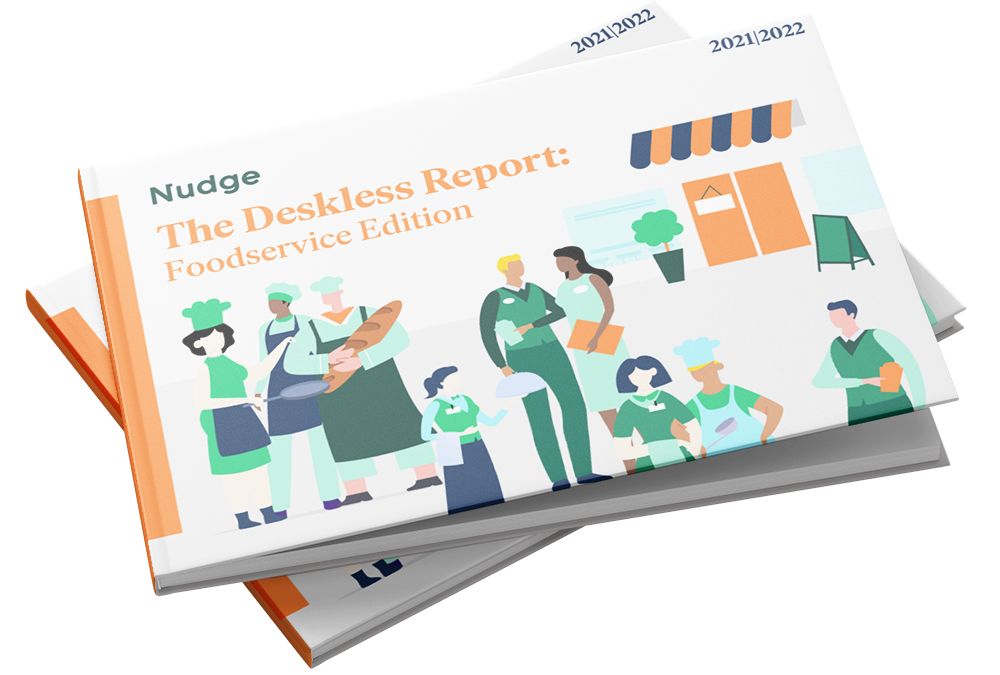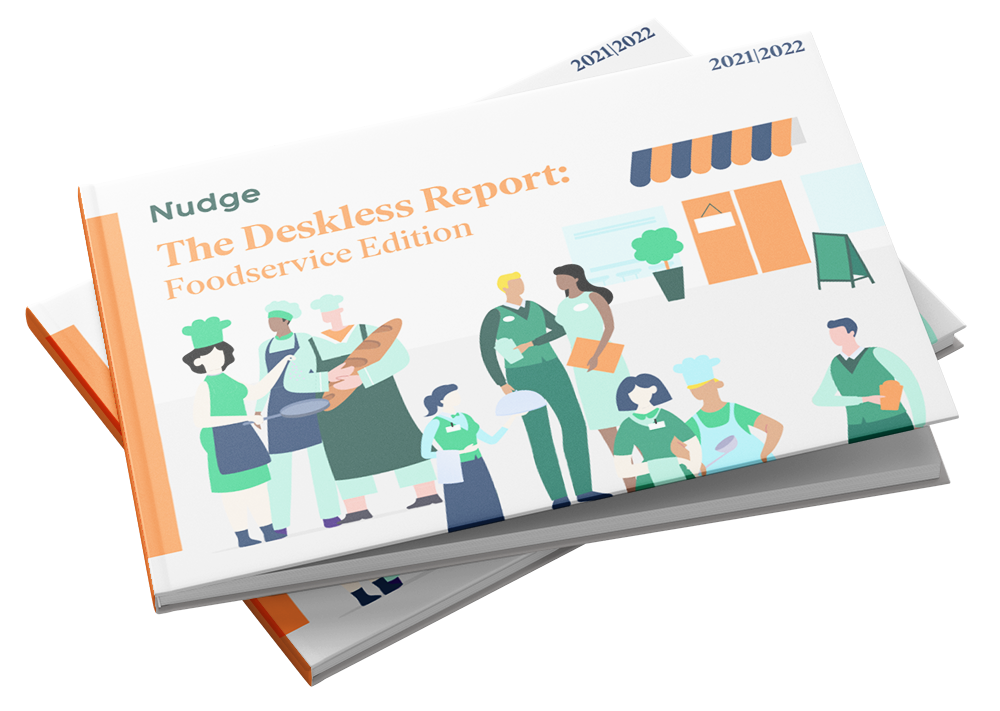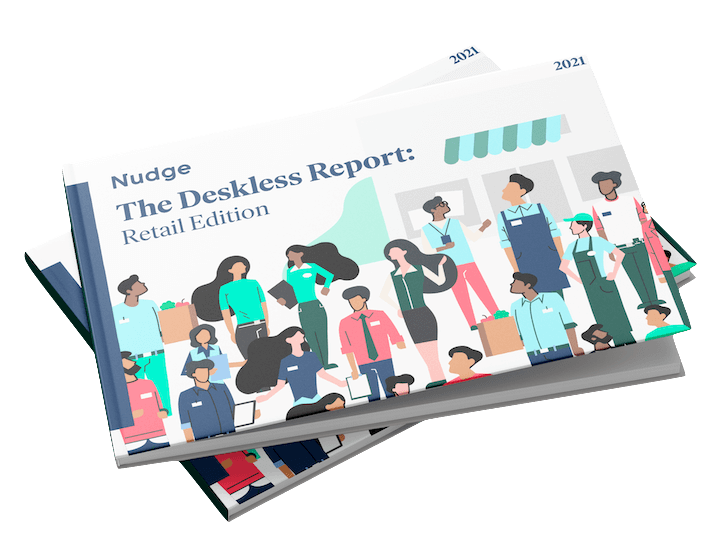
Redefining the Frontline Experience: New Data Reveals the Secret to Outlasting Retail’s Volatility
Redefining the Frontline Experience:
New Data Reveals the Secret to Outlasting Retail’s Volatility

During this webinar, we reveal new findings from Nudge’s annual Deskless Report: Retail Edition, which aggregates insights from managers, workers, and frontline leaders. Get the latest retail-specific data on the critical intermediary role of managers, and what drives associates to perform — and how both can impact the disruptions facing retailers today.
Watch this on-demand webinar to learn how you can apply these findings to:
- Redefine and reimagine the frontline employee experience
- Address key disruptors, like burnout and absenteeism
- Explore the future of frontline enablement technology

The ultimate guide to frontline team huddles
The ultimate guide to frontline team huddles
How to inspire and align your staff (in only 10 minutes a day!)
Looking to streamline processes and drive operational consistency? Reduce the strain on your managers? Drive profitability and expansion? Help communication flow? Keep customer experience top of mind? The answer is simple: pre-shift team huddles.
While team huddles have been the secret weapon of some frontline organizations for decades, these mini meetings are gaining more traction in recent years as alignment and agility are becoming increasingly critical to frontlines looking to grow and thrive.
Morning huddles can help your team stay informed and focused on your organization’s goings-on and core goals – if you do them right.
That’s where we come in. This guide will help you understand why top-performing frontlines use pre-shift team huddles and how to effectively bring these ten-minute miracles to your organization. Plus, we’ll share tried-and-true tips and tricks from our CS team.
So, let’s get started.
What are team huddles?
Also known as pre-shift meetings, morning huddles, lineups, and myriad other names, team huddles are gatherings that provide a chance for frontline teams to quickly connect on the day’s tasks, company updates, team goals or hurdles, and more. Even the deskbound world has begun tapping into these valuable check-ins by utilizing standups and scrums.
Team huddles are more than just a staff meeting. They’re a place for consistent, regular discussion in which employees at all levels communicate, share, and address key performance indicators and areas of improvement. The purpose is to provide an open channel where team members can safely voice any questions or concerns they may have. They should rarely last longer than a few minutes, and are usually led by a location manager.
Huddles are particularly valuable in uncertain times (we see you, global pandemic) or periods of rapid change at an organization, such as during an expansion. But even during “normal” times, every organization can benefit from these bite-sized meetings every day.
Why every frontline needs team huddles
According to our annual research, The Deskless Report, frontline workers are desperate for more on-the-job information. In fact, one of the top reasons that 36% of deskless workers currently want to quit their job is “poor communication.” But information is not always easy to share. Our research also found that according to deskless leaders, the #1 barrier between head office and frontline workers is (you guessed it!) communication.
That’s where team huddles come in. Do they replace your employee communication tools? Nope. But they’re part of your frontline enablement ecosystem, reinforcing timely updates and foundational information, like brand values, while also providing space for real-time feedback and recognition.
Here are a few more reasons every frontline needs team huddles:
They boost team-building
Even when a location only employs a few staff members, teams can become siloed very quickly. The simplest explanation? People aren’t talking to one another. An obvious benefit of a regular touchpoint in the form of a pre-shift huddle can be simple open communication. This leads to a place where employees grow to trust one another and are empowered to work together rather than separately. Pre-shift team huddles are an especially excellent mechanism for team-building between front-of-house and back-of-house staff in the restaurant and hospitality industries.
They create brand advocates
There’s also an employee advocacy play here, too. Employees who feel confident that they have their basic needs met to reach their full potential (things like a safe workplace, fair pay, and the tools to do the job) can become staunch advocates of the brand and company they work for. Ultimately, team huddles lead to engaged, empowered employees ready to collaborate and contribute – and tell the world why they’re proud to be a part of your brand.
They foster a feedback culture
These meetings are the perfect place to foster a sense of safety, share best practices, and allow upward feedback. According to LinkedIn’s Global Talent Trends Report 2020, it’s crucial that employers tap into and act upon employee feedback. By doing this, you are not only engaging your employees but involving them in decision-making. When given the space to share consumer insights, employees can even help increase your organization’s competitive edge.
They promote in-the-moment recognition
All employee recognition is good – but it’s even better when a worker’s hard work is acknowledged in near real time, rather than at the end of the month (or longer!). Team huddles provide the perfect space to share and celebrate. For example, employees at many Enterprise Rent-A-Car locations vote on who delivered the best service during the past week, helping increase connection and add a spirit of friendly competition to their workdays.
They drive consistent task execution
When employees don’t have a good line of sight into what everyone else is working on, there is a danger of duplicating tasks. These redundancies are inefficient and can be significantly negative for your brand if they involve your customers. Pre-shift team huddles allow you to quickly and efficiently create systems that help your business flow better. Taking the time each day, even for as little as ten minutes, to go over priorities and goals can drive consistency and task execution and can increase team cohesion and efficiency. Team huddles also give leaders a chance to act and mobilize their teams to make adjustments that improve customer and employee experience. Quickly sharing bottlenecks and identifying blockers with your team can get more employees focused on a problem so that it can be solved in real time.
They align on company goals
Goals and KPIs are the best way to tell you if you’re on target and let you course-correct to get back on track. And your daily pre-shift huddle is an ideal place for reviewing metric updates, short-term priorities, and overall company goals. Managers can even use huddles to align their teams on priorities and drive performance in a fun way by tying your employees’ successes back to the company’s values and goals.
How to bring team huddles to your organization
Team huddles have the power to drive employee engagement and operational consistency… but to make that happen, you have to be consistent about it. Telling your managers to have a quick ten-minute sync-up each day isn’t enough. You need to implement the right processes and tools to ensure that every location is using huddles the same way. The information shared doesn’t need to be the same across the organization, but the process should be.
Here’s how to implement team huddles at scale:
Step 1: Identify the “why”
If there’s one thing we love here at Nudge, it’s the “why.” When implementing any initiative, sharing the “why” with your staff is the best chance at widespread adoption. But before you can share it with them, you have to identify the “why.” So, why are you implementing team huddles? Which of the business drivers we already explored is most critical to your organization? Are you looking to drive consistent task execution? Are you hoping to open up more channels for upward feedback? Is the business going through a period of growth and you want to keep staff in the know? Thinking about this will help you provide extra context to your staff in a later step.
Step 2: Get the right tech in place
For team huddles to work at scale, you need the right technology and tools in place. Keep in mind: To achieve organizational consistency, you want to standardize the process across locations and regions, while allowing for a certain amount of personalization from managers. Our recommendation? An agenda. More specifically, a frontline enablement solution that combines task management and internal communication. Having your huddle meeting agenda baked right into your existing solution keeps everything in the same place.
Think about it: Let’s say one day’s pre-shift team huddle includes a review of SOP for end-of-day closing. When your agenda is baked into your frontline enablement solution, staff can access the closing checklist – as well as access additional training and learning resources – all in one place. Plus, if a staff member misses the meeting, they can access the talking points and even check off that they have read the information.
Step 3: Get your managers on board
Once you have the “why” and your tech ready to go, you’re prepped to get your manager buy-in. Without your managers, your team huddles will fall flat, fast. It’s critical that you take the time to educate them on the value of these mini meetings – not just for the company as a whole, but for the managers themselves. After all, managers are the ones up against it. Now more than ever, they’re wearing many hats, so finding ways to standardize and simplify processes and protocols is win-win. Share with them the benefits of team huddles and the value of regular, consistent information sharing.
Success tip 💡
If you have a frontline enablement solution in place, you might even be able to back up this information with data, showing how locations that participate in recognition and feedback programs have higher revenue numbers or lower turnover.
Step 4: Share the “why” with your staff
Next, it’s time to loop in your workforce. To encourage widespread adoption of this daily ritual, you’ll want to make sure your workers know the value of these meetings. Here’s where the “why” comes into play again – don’t just explain the new process, explain the reason. So, that message might look like this:
“We’re always looking for ways to improve communication and alignment across the organization and provide additional channels to acknowledge and celebrate your hard work. That’s why we’re excited to announce that we’re implementing pre-shift team huddles at every location. These daily meetings will last no longer than ten minutes and will provide an opportunity for teams to quickly review company announcements and monthly goals, address hurdles or issues, and celebrate staff members who have gone above and beyond.“
Step 5: Standardize the process
The most successful team huddles focus on consistency. To drive operational efficiency, you’ll want to standardize the process, while leaving room for managers to drive their own tactical and engagement initiatives. But how can you ensure that 170 locations across the country (or the world!) are sharing the same information at their huddles?
Here’s where getting the right technology in place pays off. When you execute your huddles through your communication or enablement solution, you’ll be deploying the same agenda items to every location. With Nudge, head office can share mandatory and suggested items with links to relevant resources. Managers can then supplement that agenda with their own custom topics, like star performer call-outs, regional updates, or even add in additional “approved” topics from a head office-populated list.
In the team huddle, managers and employees open up the agenda and review the items for the day, checking them off as they go. This helps huddles to run faster and more effectively, because managers can spend more time on team building and addressing issues versus simply relaying information. The checklist also ensures managers can track who has received the updates, ensuring full, consistent visibility across your workforce (no matter how big!), while still avoiding duplication of information.
Step 6: Monitor at scale
One more reason to deploy your team huddles using a frontline enablement solution: the analytics! Sure, you could leave your managers to conduct these meetings old-school. But leveraging technology ensures that every team huddle can be easily tracked, so you can see at a glance what’s being added to agendas and what topics need more attention – so you can steer the conversation accordingly. You can even see what items are getting checked off and when, allowing you to get full visibility on how information is getting disseminated. Pair this with a resource hub and knowledge-testing questions, and you’ll have the ability to check the confidence and preparedness of your entire workforce. Magical, right?
Success tip 💡
Monitoring at scale can also help to drive company-wide adoption. If you know which locations are consistently doing team huddles (and which are lagging), you can celebrate the behavior you want to drive. Acknowledge the teams that are making team huddles a daily ritual as a way to encourage other locations to follow suit.
The anatomy of a perfect team huddle
You’ve got your tools – check! You’ve prepped your staff – check! You’ve got buy-in from your managers – check! Now it’s time to start running your huddles. But what goes onto the agenda? These meetings are ten-minute miracles for a reason. Anything beyond a few minutes starts to have diminishing returns. So, how do you make those few minutes count?
Download the full guide to learn more!
Download the full guide to read more!
Share your details below to get the full guide, which includes guidelines and examples to help you structure your team huddles, as well as tips to optimize your huddles from our CS team!
Thank you for your interest in our ebook. Access the pdf here.
Visit our Resource Hub to explore additional resources for influencing and inspiring your frontline employees to drive meaningful results.

The ultimate guide to writing and sharing effective frontline communications
The ultimate guide to writing and sharing effective frontline communications
Learn to write clear, creative communications – and save time along the way!

Ah, the struggle of frontline communication teams: you want to do everything you can to drive knowledge retention and employee engagement, but to do that, you need truly effective communications – and that takes a lot of time and effort.
The Nudge customer success team is here to help! In this guide, we’re giving away all our secrets and serving up a collection of tried-and-true tips that any frontline organization can use to write creative, effective communications, while saving time and energy.
Download the guide to learn:
- Why writing creatively is the secret to effective internal communications
- How to write creatively (plus an exercise to put it into practice!)
- How to build a content strategy and use campaigns to save time
- Plus: a free internal communications campaign builder!
Thank you for your interest in our ebook. Access the pdf here.
Visit our Resource Hub to explore additional resources for influencing and inspiring your frontline employees to drive meaningful results.

The Deskless Report: Foodservice Edition 2021
The Deskless Report:
Foodservice Edition

Nudge surveyed restaurant workers and leaders from across the country to learn what keeps leaders up at night (hint: it’s the labor crisis!), and what workers need in order to deliver next-level guest experiences, level up execution, and achieve operational efficiency.
In exploring the viewpoints of both restaurant workers and leaders, this report delves into the disconnect between them – the gaps between what staff want and what organizations are providing.
Download the report to learn:
- What drives engagement and motivation in foodservice workers
- The #1 challenge facing operators right now
- The state of foodservice worker communication
- The state of foodservice worker feedback
- How foodservice leaders are investing in EX in the coming year
Thank you for your interest in our ebook. Access the pdf here.
Visit our Resource Hub to explore additional resources for influencing and inspiring your frontline employees to drive meaningful results.

The Deskless Report: Retail Edition 2021
The Deskless Report:
Retail Edition

In June 2021, Nudge surveyed retail workers and leaders from across the country to answer one question: “What’s the state of the retail workforce?”
In this report, we’re looking at who retail workers are, and what they desperately need in order to deliver next-level CX, execution, and operational efficiency. But we’re also looking at what keeps retail leaders up at night (hint: it’s the labor crisis!), and how they’re investing in employee experience next year and beyond. We’ve also got behind-the-scenes spotlights on retail brands that are successfully driving business outcomes by investing in the associate experience.
In exploring the viewpoints of both retail workers and leaders, this report delves into the disconnect between them – the gaps between what associates want and what retailers are providing.
Download the report to learn:
- What drives engagement and motivation in retail workers
- The #1 challenge facing retailers right now
- The state of retail worker communication
- The state of retail worker feedback
- How retail leaders are investing in EX in 2022 and beyond
Thank you for your interest in our ebook. Access the pdf here.
Visit our Resource Hub to explore additional resources for influencing and inspiring your frontline employees to drive meaningful results.
